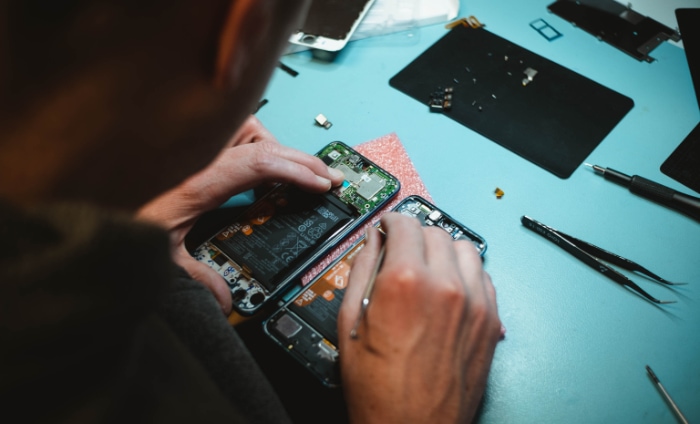Black Spots on Phone Screen: Decoding the Display Dilemma

Black spots on phone screens are a common concern for many smartphone users. These unsightly blemishes, whether tiny specks or larger patches, can greatly diminish the overall user experience, often making it difficult to view content or even operate the device.
Whether you've faced this problem before or are just curious about it, read on to gain a deeper understanding of this widespread issue.
What Are Black Spots?
When one encounters an unexpected blemish on their phone screen, it can be both confusing and alarming. But what exactly are these black spots? Here's a closer look into the nature of these anomalies.
Physical vs. Digital Black Spots
Before diving deep, it's essential to understand the difference between physical and digital black spots. Physical black spots are usually the result of damage to the screen's actual surface or layers underneath.
They are tangible, might have a raised or indented feel to them, and can be due to a multitude of reasons including external trauma or manufacturing issues.
On the other hand, digital black spots, often referred to as dead or stuck pixels, are a malfunction of the screen's display. They are not the result of physical damage but are instead related to the device's internal hardware or software components.
Dead Pixels vs. Stuck Pixels
These terms are often used interchangeably, but they have distinct differences.
- Dead Pixels: These are pixels on the screen that do not light up at all. When the rest of the screen is illuminated, these pixels remain black. A dead pixel is typically a result of a malfunctioning transistor associated with that particular pixel.
- Stuck Pixels: Unlike dead pixels, stuck pixels are always on. They might appear as a constant red, blue, or green dot on the screen. This happens when one or more of the sub-pixels remain on or off, causing it to display the wrong color.
Recognizing Physical Black Spots
Physical black spots are more straightforward to identify. They may resemble smudges or dirt at first glance but do not wipe away.
They are usually irregular in shape and can be felt when running a finger across the screen. Factors like an impact or pressure often cause them, and they may be accompanied by other visible signs of damage.
Causes of Black Spots on Phone Screens
Black spots on phone screens aren't just random occurrences. There are various underlying reasons that can lead to these imperfections.
By understanding the root causes, phone users can take preventive measures and seek the right solutions when confronted with such issues.
Physical Damage and Its Impact
One of the most common reasons for black spots, especially the physical kind, is external trauma. A sudden drop, accidentally sitting on the phone, or even placing heavy objects on it can cause the delicate screen components to malfunction or become damaged.
The resulting black spots are often irregular and may coincide with cracks or other visible signs of damage.
Moisture Intrusion and Display Technology
Water is not a smartphone's best friend. Even a small amount of moisture finding its way inside a phone can wreak havoc on its internal components, including the screen.
While some modern phones come equipped with water resistance, prolonged exposure or immersion can still lead to display problems. The moisture can cause short-circuiting of the pixels or affect the connectors, leading to black spots or patches.
Manufacturing Defects and Screen Issues
While manufacturers take great care to ensure that every unit leaving their facility is in perfect condition, occasional defects can occur. Some phones might come with inherent screen issues due to manufacturing glitches.
These defects can manifest as black spots, uneven backlighting, or other screen abnormalities.
Age of the Phone and Wear and Tear
Everything has a lifespan, including the components of a smartphone. As a phone ages, its components can start to degrade.
Over time, the constant use and the continuous lighting and darkening of pixels can lead to some of them malfunctioning. These malfunctions often result in dead or stuck pixels, contributing to the appearance of black spots.
The Role of Temperature Extremes
Exposing the phone to extreme temperatures, whether scorching or freezing, can be detrimental. High temperatures can cause components to expand and potentially damage internal parts of the display.
Conversely, cold temperatures can make materials brittle and more susceptible to damage. Rapid shifts between these extremes can further exacerbate the issue, leading to the formation of black spots.
Why You Shouldn’t Ignore Black Spots
While a small black spot on your phone screen might seem like a minor annoyance, leaving it unaddressed can lead to more significant problems over time. It's more than just an aesthetic concern; it's an indication of the health of your device.
Degradation of User Experience
A pristine display is crucial for the best user experience. Whether you're watching videos, browsing the web, or editing photos, black spots can be a major distraction.
Over time, as you continually notice these spots, your overall satisfaction and enjoyment of your device can diminish, making tasks less enjoyable or even straining to the eyes.
Potential Indicators of Larger Issues
A single black spot might be the proverbial tip of the iceberg. It could be an early sign of broader screen failure or other internal issues, such as moisture damage or malfunctioning components.
By addressing black spots early, you might be preemptively dealing with a problem before it worsens and affects the device's functionality.
Impact on Resale Value
If you're considering selling your phone in the future, its condition plays a significant role in its value. Potential buyers are less likely to be interested in a device with visible screen defects, or they might offer a reduced price.
Keeping your screen in top-notch condition ensures that you get the best possible return on your investment.
Risk of Spreading
In some cases, especially with physical damage or moisture intrusion, what starts as a small spot can expand over time. As the compromised area of the screen continues to degrade, it can lead to larger areas of discoloration or malfunction.
Addressing the issue early can prevent this from happening.
A Reminder of Vulnerability
Black spots, especially those caused by physical damage, serve as a reminder of the vulnerability of modern smartphones. They underscore the need for protective measures, such as using robust cases or screen protectors.
Taking action upon noticing a black spot can prompt better care of the device in the future.
Addressing the Problem: Why DIY Isn’t Recommended

It's tempting to take matters into our own hands when faced with a problem. The allure of quick online fixes or the satisfaction of personal problem-solving can be compelling.
However, when it comes to black spots on phone screens, the DIY approach isn't always the wisest choice. Let's explore why.
Complexity of Modern Phone Architecture
Today's smartphones are marvels of engineering. Their intricate designs house a myriad of delicate components all working in harmony.
Even a small misstep during a DIY repair can result in misalignments or damage to these critical parts, potentially exacerbating the original issue or introducing new problems.
Potential to Worsen the Problem
While there are countless tutorials and kits available, not all of them are reliable. Some methods might offer a temporary fix but could lead to longer-term damage.
For instance, applying too much pressure in an attempt to rectify a stuck pixel could damage surrounding pixels or other parts of the display.
Voiding Warranties and Other Risks
Most manufacturers have strict guidelines about device tampering. Opening your phone or attempting a repair can void the warranty, leaving you without support if further issues arise down the line.
Furthermore, without the proper tools or environment, there's a risk of introducing dust or other contaminants inside the device.
Lack of Proper Diagnostics
Professional technicians have the tools and knowledge to accurately diagnose the cause of black spots. A DIY approach might address the symptom (the black spot) without truly resolving the underlying cause, leading to potential recurrence or other related issues.
Safety Concerns
Smartphones contain batteries that, if punctured or mishandled, can be hazardous. Additionally, the risk of electrical shock, though minimal, is present when dealing with electronic repairs without proper precautions.
Professional Repair: The Safer Choice
Opting for a professional repair over a DIY approach may seem like an obvious choice for some, but the reasons extend beyond the potential pitfalls of self-repair. Engaging experts ensures that the repair process is thorough, safe, and tailored to address the unique needs of your device.
Expertise in Diagnosing the Issue
Trained technicians bring with them a wealth of experience in handling a range of smartphone issues. They can accurately determine the root cause of black spots, be it moisture damage, a manufacturing defect, or something else entirely.
This precise diagnosis ensures that the repair addresses the core problem, preventing future recurrences.
Access to the Right Tools
Professionals are equipped with specialized tools tailored for smartphone repairs. Whether it's a machine to safely open the phone without damaging its components, or precision instruments to replace tiny parts, having the right tools ensures that the repair process is efficient and effective.
Quality Parts for Replacement
When parts need replacement, professionals typically have access to quality components, either directly from the manufacturer or from trusted third-party providers. This guarantees that any replaced parts are compatible with your device and meet industry standards, ensuring the longevity and performance of your phone.
Warranty and Assurance
Many professional repair services offer warranties on their work. This means if the problem persists or if a new issue related to the repair arises, you'll be covered.
This assurance is something DIY repairs cannot provide.
Time Efficiency
While the allure of fixing something yourself can be strong, the time investment, especially without prior experience, can be significant. A technician with experience can typically complete repairs much faster, getting your device back into your hands sooner.
Data Protection and Security
A notable concern when handing over devices for repair is the safety of personal data. Established professional repair centers often have stringent data protection protocols in place, ensuring your photos, messages, and other personal information remain confidential and secure.
Conclusion
Smartphones have become an essential part of our daily lives, acting as our primary communication tools, entertainment devices, and so much more. Black spots on phone screens, while seemingly small, can significantly impede our experience and hint at deeper underlying issues.
While the DIY spirit is commendable, certain problems, especially those related to intricate devices like smartphones, are best left to professionals. Trusting experts ensures the longevity of your device, preserves its performance, and ultimately protects your investment.
By understanding the nature, causes, and best remedies for black spots, users can make informed decisions, ensuring that their devices remain in optimal condition for the longest time possible.


